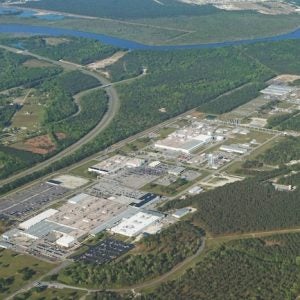The plan, which has been called ‘Mega Moly’, envisages a new production plant that would produce three times as much as current production levels, approximately 140,000 six-day Curies/yr when it starts up in 2016. Greg Storr, general manager of ANSTO nuclear operations, said that the sale of this Mo-99 would generate A$100 million/year in revenue. (Projections elsewhere in this article, including Figs. 2&3, have not been updated to reflect this development).
Although the production process is as new as the OPAL research reactor—it only went critical in 2006—the Mo-99 production facility is expected to reach the end of its life in 2017. That is because although the process now uses low-enriched uranium irradiated target plates from OPAL, it was been installed in a suite of 40-year-old hot cells that had previously processed material from the HIFAR reactor, which was shut down in 2007. The current process was supplied by Argentina’s INVAP and is based on the CNEA production facility.
In announcing the new plant, Chris Evans, minister for tertiary education, skills, science and research, said that production of Mo-99 is ‘technically difficult.’ After the plates are irradiated in OPAL, they are transferred to the production facility and dissolved in an alkaline solution. Only 2% of the uranium in the target plates is fissioned, and Mo-99 represents only 6% of this amount. The Mo-99 is extracted in a series of separation and purification steps. The final product volume is 20 mL, of which Mo-99 represents only approximately 100 mg. The half-life of Mo-99 is only 66 hours, so the process must be completed as quickly as possible. Operations have to be carried out remotely in a hot cell. The process produces fission gases that need to be filtered, and radioactive liquid waste that needs storage and treatment. The new process will be based on the alkaline-based process technology of South African producer NTP, which is ANSTO’s international collaboration partner. NTP is a subsidiary of NECSA, South African Nuclear Energy Corporation, which also irradiates LEU-based target plates from the SAFARI-I research reactor.
An ANSTO nuclear medicine Mo-99 project team was completing concept design in mid-November; preliminary design will take until April 2013 and detailed design until September 2014. Construction is scheduled to begin in June 2014, after which commissioning will start. No contracts will be awarded until the detailed design stage in mid-2013. The total budget for the Mo-99 plant is A$98.3 million.
Also planned for the site is a demonstration plant of the Synrock radwaste immobilisation technology, an Australian-invested technology that will encapsulate intermediate-level liquid waste from the Mo-99 process. The process, which produces a ceramic end product, is claimed to reduce waste volumes. In testimony to an Australian congressional committee, ANSTO CEO Adi Peterson compared the waste generated by cementation and Synrock. He said that cementation would expand 2000L of liquid radwaste into 50000L, but the Synrock process would reduce it to 500L. Cemented waste would require 150 transport trucks, he said, versus three for Synrock waste. The total budget for the Synrock plant is A$70.5 million.
Author Info:
This article was first published in the December 2012 issue of Nuclear Engineering International. By Will Dalrymple, editor of NEI.
Related ArticlesFrench/Australian research partnership Australia could supply nuclear medicine to USA Molybdenum-99 market supply and demand South Africa’s Safari 1 wins $25 million isotope contract ANSTO executive takes key role in global nuclear body






